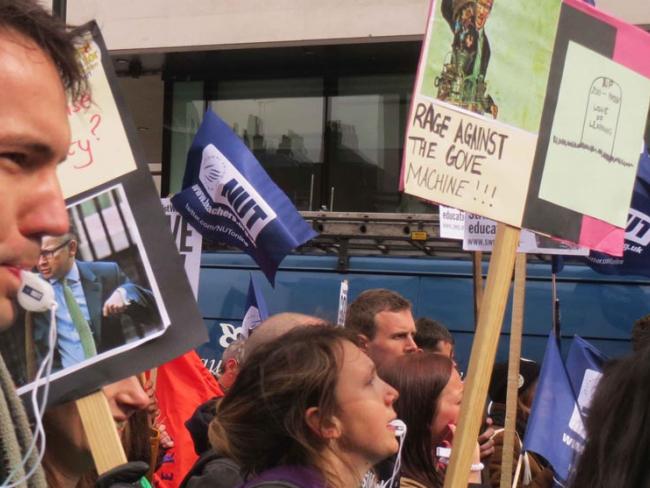2 September 2015

Teachers striking against workload, bureaucracy, low pay and poor pensions march in London, March 2014. Photo Workers.
“There has never been a better time to be a teacher,” boasts the Department for Education’s advert to would-be recruits, accompanied by photos of smiling, happy teachers in the classroom. But statistics from the Universities and Colleges Admissions Service quietly released at the end of August tell a different story: we are heading for a full-blown teacher supply crisis.
For the third year running, ministerial recruitment targets fell woefully short. In geography the target of 778 geography trainees for this September has resulted in 580 actual recruits. In technology there are just 550 trainees out of a target of 1,279. The target for English of 2,253 has been missed by more than 10 per cent, with only 2,000 recruits. And so on.
Overall there is a 10 per cent shortage in applicants. According to teacher union the NUT, the recruitment rate onto training courses is just under 14 per cent below what it was in 2010. Only in foreign languages does supply outstrip the government’s target, probably due to immigration.
The acute shortage of maths teachers has already forced secondary headteachers to double up classes or to ask teachers of other subjects to step in. Often there are no applications for vacant maths posts.
So why is this happening?
Training mess
Initial teacher training has become a confusing mess after Michael Gove, education secretary in the last government, pushed the move away from universities to schools, creating a “competitive” market for recruiting would-be teachers. His introduction of the School Direct programme, in which schools rather than universities bid for training places, has been a shambles.
School Direct could almost have been designed to undermine proper national planning in subject specialisms and geographical spread. It has seriously under-recruited, as would-be students have shown a clear preference for university-led training. And it has led to the closure of some highly respected university training departments.
‘The scale of its failure is staggering.’
The scale of its failure is staggering. For 2014-15, School Direct recruited just 61 per cent of its allocated places. Government reacted by increasing the School Direct allocation by 13 per cent and reducing the university places by 5 per cent for 2015-6.
Now the government has announced that strategic planning for teacher supply will be entirely handed over to market forces. From September 2016, there will be a free-for-all. Although there will still be national government recruitment targets, it will completely abandon planned allocations of places to training providers.
Once the targets have been met (if they are, which seems unlikely) funding will cease. So effectively, no planning at all – this will make it even more risky for universities, which must plan ahead, to continue to train teachers.
Adding to the mess are expensive schemes such as Teach First, introduced by Labour under the illusion that Oxbridge graduates with first class degrees would make the best teachers when plunged straight into the most difficult schools. In practice, most Teach First trainees have left the schools they trained in at the end of the compulsory two years.
Population growth
The school population is increasing rapidly – immigration and sharp rises in the birthrate mean that half a million additional children will need places over the next five years.
This has led to a crisis in primary school places in many parts of the country, with local authorities scrambling to cope by expanding existing schools (they aren’t allowed to build new schools).
‘The problem is now moving from primary into secondary schools.’
The resulting increased demand for primary teachers in areas such as London (there is already a national shortfall of 7 per cent), where housing and transport are very expensive, has also led to significant recruitment difficulties to permanent posts. Salaries are not enough, even with London Weighting, to even rent, let alone to buy a place to live. This problem is now moving into secondary schools.
Sadly, students are finding teaching as a profession much less attractive. Postgraduates now have to pay the full £9,000 a year fees to train, even in school-based schemes, while salaries are set to rise by no more than the 1 per cent public sector pay freeze.
They see constant meddling, changes in the curriculum, the misery of inspections, and attacks on the profession from government and its cronies, combined with a long-hours, pressurised culture. And if they know practising teachers, these are likely to be considering leaving the job – 40 per cent leave in the first five years – a terrible waste of skills and public money.
Unions
Academy schools – publicly funded but privately run – do not have to employ qualified teachers as the state sector does. David Cameron recently announced that he wants to see all schools become academies in the future. In the face of a crisis it has itself engineered, will government abandon the organised training of teaching altogether?
The supply shortage should be treated as an opportunity for teacher unions to organise in schools to improve their working lives and incomes. As part of this, teachers need to defend the graduate nature of the profession, and the essential and major role of universities in training.
